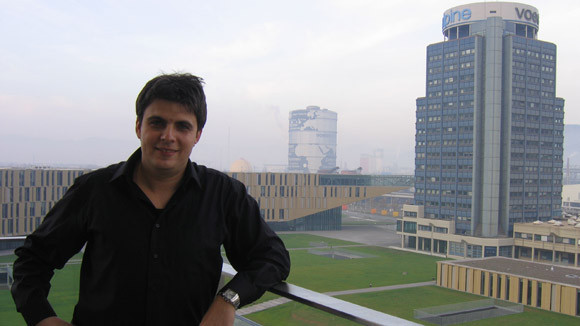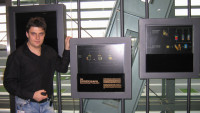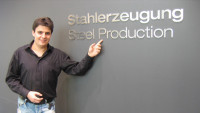Slovak scientist Daniel Križan, thanks to his work, became world famous. The steel industry has given him recognition even though he is 33 years of age.
He studied abroad and his professional contributions are presented at
international conferences and reputable scientific journals.
In December 2009 he invented a new kind of steel. Currently he is working for the fifth year in Linz, Austria in a steel company which is engaged in research of high strength steels for the automotive industry. Since September he will also be a visiting professor at the prestigious Johannes Kepler University in Linz.

Slovak scientist Daniel Križan is only 33 years of age, but has achieved
worldwide success.
(Photo: Ing.Veronika Galbavá)
Why did you decide to specialize your studies in steel?
I graduated from the Faculty of Material Science Technology, Slovak University
of Technology (MTF STU) in Trnava. In the second year I was very interested in
the subject of physical metallurgy and then I decided to join the field of
Materials Engineering - Metallic Materials. I started dealing with steels in
the fourth year as a student in scientific and professional activities.
When did you first began to achieve scientific breakthroughs?
Already during my engineering studies I sensed scientific work. I went to
various student conferences with international participation, most of which I
managed to win. I graduated in 2000 with a red diploma and at that time I was
the best student of the university. For excellence in study I received the
Rector's Prize.
- He is also the winner of the Canadian metallurgical company, which he received in 2003 in Vancouver. Even during your studies you are famous abroad. How do you manage that?
Each scientist presented his work in professional journals or at various
scientific conferences. I had the opportunity thanks to my work to have traveled
the world. I was in Canada in Vancouver, in the U.S. in Chicago and Denver. In
the first conference in Canada, I received the award for Canadian metallurgical
company for the article on the development of TRIP steels (Transformation
Induced Plasticity of steels - steels with transformation induced plasticity).
How did you feel when you passed right price at the first conference?
Incredibly. I did not know that I won a prize. I did not expect it. I was very
proud of myself, mainly because there was an international competition with Canadians,
Japanese and Americans. I was there among the winners as the only European.
What is your biggest success you have so far achieved in your work?
- In December of 2009 I managed to develop a new type of TRIP steel, which is of excellent ductility and has great strength.
I have two European patents on this steel. I worked on developing this for a couple of years it was a piece of drudgery. Eventually it was a great feeling and great satisfaction.
So you can say about yourself that in your field you are most successful Slovak?
I think so, I think I may say that in my field I am Slovak number one.

From September Daniel Križan will work as a visiting professor at a prestigious
university.
(Photo: Ing.Veronika Galbavá)
Explain to us how the development of new steels is going.
I work as a project manager, I am dedicated to research and development and
high-strength steels for the automotive industry, which contains residual austenite
- TRIP steel. This is a specific type of steel that is on one hand, very strong, but on the other hand can be very
wrought. To some extent we're going against nature, while simultaneously
improving strength and ductility of the material.
First, we must make steel in the laboratory. This is no alchemy, before hand we
need to know what elements we want to add to the steel to gain the desired
properties. This we find by computer simulations and, consequently, their
testing. From a number of laboratory castings emerge - one or two best steels, then they are implement into production. The
laboratory works in castings that weigh about 200 to 300 kg, the production is
already over 150 tons.
The entire production process from casting, hot rolling and cold, and
subsequent annealing and coating must be closely monitored and possibly errors corrected.
When the steel is in the form of galvanized sheet metal and has yet to be tested
for its workability and welding ability.
In December 2009, we developed a new
type of TRIP steel, for which we have two European patents.·
Full testing of proposals are to be evaluated and coordinated. In addition to
the development and testing process, I am also responsible for communicating
with clients to introduce new steel. We work with several major global
automakers.
What significant changes in recent years has metallurgy seen?
Recently, a large "boom" in the development of steels for the
automotive industry due to growing competition from light metals, especially
aluminum. Over the past 15 years the strength of these steels has increased four-to
fivefold! The European Union is pushing the car industry to global warming due
to radically reduce carbon dioxide emissions and therefore there is a lower fuel
consumption of newly manufactured vehicles.
One way to achieve this is to develop higher strength steel. Since then the
body components made of these steels may be thinner and thus reduces the
overall weight of the car, resulting in its lower consumption and lower
emissions of carbon dioxide. Plus, thanks to the higher strength it gives more resistance
to impact of the cars, so they are also safer.
Already at a young age you have achieved success that some scientists work for
all their life. Not think of you as an academic path that you have moved even
further?
Although I am only 33, in Austria, I could already be a university professor. Their
system is different than in Slovakia.
Meanwhile, in addition to my work I have also been offered to become a visiting professor at the Jan Kepler
University in Linz, I will start from September this year. This means lecturing
physical metallurgy, metal physics, in essence, two hours a week, so I can
still work well to combine this with research.

Voestalpine Stahl GmbH, a steel plant in Linz, Austria, in which there is the work of the Slovak scientist. (Photo: voestalpine.com)
You are Slovak and in Austria you have a very high position. Do Austrians make
you feel that you are one of "them"?
In this respect, I felt no pressure because I'm Slovak. But it is quite
possible that it's because I come from Belgium. I came from a higher level than
it in Austria. If I came from Slovakia, I would have been given a different
experience. The narrative is, I know that here there is some underestimation,
because we have a former socialist country.
Abroad, you are known, but what about in Slovakia? Do you think that your
countrymen and experts from the field steel know about you?
Feedback on my work from Slovakia has sporadically been recorded. So far I have
not shown myself in Slovakia, except in my native University in Trnava. Now I
have entered the scientific community for the Doctrine of the metals at the
Slovak Academy of Sciences (SAS).
The scientists say their life is science. Is this also in your case? What is
important to you besides work and research?
(Smile. ..) I think it's largely true. When I was younger, I focused almost all
my time on study and career. It was paramount for me. Then I realized that I
wanted to start a family and settle down. That's why I decided to not work far
from Slovakia, so I could find a woman ... (laughs).
Now for me the most important thing is family. I recently got married, my wife
is Slovak. She followed me to Linz. We are considering to start a family. When
I come home I try spend time with her and I don't think about work.
Is it still true that many successful people from different disciplines in
Slovakia leave the country, why is this so?
This is certainly because of the unflattering terms given in science and
research, particularly regarding finance. Each government says that they will
give more money for science, but it is still very untrue . Therefore science in
Slovakia can be very difficult to develop.
Slovakia's contribution to science and research is less than 0.5% of the gross
domestic product (GDP), which is unfortunately very little. Just for
comparison, the Czech Republic invests in R & D about 1.5% of GDP and
Austria even more than 2.6% of GDP.
Our company has R & D and also underestimates the amount contributed in
excess of 100 million euros a year. In a matter related to finances and how
much Slovak scientists earn they even have outdated equipment. The second thing
is that in Slovakia we mainly manufacture research links with industry which
are unsatisfactory. I do not want to say that there is nothing, but compared to
other countries it is very weak.

Steel genius Daniel Križan goes against nature.
(Photo: Ing.Veronika Galbavá)
Introducing Dr.Ing. Daniel Križan who is a scientist in the field of material engineering, development of steels for the automotive industry.
Born in 1977 in Bratislava. In 2000 he gained his title in materials
engineer-technological at the faculty of the MTF STU in Trnava.He has doctorate in material engineering, specializing in the development of
high strength steels for the automotive industry and he was awarded this in
2005 at the University of Ghent, Belgium.
He is the winner of the Canadian metallurgical company, which he gained in 2003
in Vancouver. During his studies he became the first non-Belgium leader at the
University of Ghent, he spent three years managing the department of vacuum
metallurgy and casting.
In December 2009, he developed a new type of TRIP steel, in which he has two
European patents. He has authored about 20 scientific publications presented at
international scientific conferences mainly in the U.S. and Canada that have
been published in foreign journals.
He currently works in the Austrian Voestalpine Stahl steelworks in Linz as the
main coordinator of research and development of high strength steels for the automotive
industry containing residual austenite.
To contact the author,
Photo Gallery:
http://tvnoviny.sk/sekcia/specialy/rozhovory/oceliarsky-genius-zo-slovenska-ide-proti-prirode.html
Translation: Anthony James Ronald Atkinson

